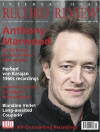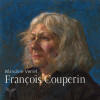Texte paru dans: / Appeared in:
*

International Record Review - (09/2012)
Pour
s'abonner / Subscription information
Aparté
AP036

3149028016628
Consultez toutes les évaluations recensées pour ce cd
~~~~ Reach all the evaluations located for this CD
Given her stature among recorded harpsichordists, fisc breadth of her repertoire and the extraordinary personality of her playing it is debatably one of the greatest injustices of the discography that so little of Blandine Verlet’s substantial recorded output — around 100 discs over more than 40 years, including the complete solo works of François Couperin, Louis Couperin and Rameau remains in the active catalogues (It is thus a little unfortunate that ten of these 32 pieces appear on Astrée/Naïve’s two-disc set of highlights from her Couperin traversal. That is the one of her recordings that listeners eager to hear her in this repertoire will most likely already have, although some of the others can be obtained by deep-pocketed online shoppers not averse to paying sums ranging, in Euros, well into three or even four figures.) Unlike that Naïve compilation, the new release preserves Couperin’s ‘orders’ intact: five of the 27 ordres, taken from Couperin’s second (1717) and fourth (1730) books of harpsichord solos.
Those who are acquainted with Verlet’s playing will need no recommendation from me; those who are not have a delightful discovery ahead of them. There are few if any harpsichordists who can quite match Verlet’s extraordinarily poetic freedom of delivery: anything but metronomic, intensely concentrated, constantly varying the vertical alignment of chords and lines — and in its consistency across the decades seemingly immune to changing performance fashions.
These new recordings are certainly keenly awaited — can it really be nearly a decade since Verlet’s last major solo release? They are rather more sumptuous in sound and more intimately captured than their predecessors on the Naïve compilation. There is a little accompaniment from the mechanism and even the occasional inhalation from Verlet herself but these sounds prove unobtrusive and indeed apt (certainly anything but ‘extraneous’) . The harpsichord is rather a late model: a 1751 Henri Hemsch, lovingly restored by Anthony Sidey and tuned by him in a temperament which gives Couperin’s harmonies their full and necessary complement of spice. (One needs only to wait until 1’37” in the very first track to hear how the tuning enhances an otherwise relatively conventional cadence .) There is plenty of richness in the low register — a prerequisite in any case for this music — but also enough resonance in the treble for pieces such as ‘Les Pavots’ from the 27th ordre (pitched for bars at a time at the very top of the instrument) to sing.
The seventh ordre contains the mini-suite ‘Les petits âges’ , in which ‘Les Délices’ supplies a particularly sonorous exploration of the Hemsch’s resources — both its rich low register and the extraordinary effect Couperin’s ceaseless stream of ornamentation. (The third couplet is a particular treat: the piece’s only significant departure from its home key, taking a modulating sequence into the depths of the instrument.) Verlet then chooses a particularly treble-heavy registration for the following ‘La Basque’, offering an agreeably strident contrast. The passage from the relatively calm G major/minor of the seventh ordre pieces to the brooding B minor of the eighth ordre shifts the intensity up a gear. The eighth ordre comes closest to the traditional selection of dances of the stereotypical suite structure, with ‘La Raphaèle’, despite its lack of quick sections, standing in nicely for the Ouverture. The second disc contains three complete ordres (they diminish steadily in length over the course of Couperin’s publications — the first ordre contains 18 pieces, the second 23, the 27th just four).
Couperin’s dictum ‘I much prefer that which touches me to that which astonishes me’ is, of course, apt. Although there is not so much in the way of sheer astonishment ( à la Forqueray) to be had here, close listening provides rich rewards: for all its economy of means this is immensely wide- ranging music and the rewards of immersing oneself in its flow are tremendous. Verlet’s playing might not be the most extroverted on offer; rivals such as Pierre Hantai and Mitzi Meyerson are certainly more outgoing in style and offer consistently attractive playing, Hantaï in particular with a more precise rhythmic profile. To me, however, it is Verlet’s style which seems perfectly attuned to these elusive works. I do hope that we will not have to wait so long for Verlet’s next solo release — and that whoever is now in control of the Astrée catalogue might see fit to share the extraordinary riches from decades of Verlet’s recordings that are currently kept securely locked away.
Cliquez l'un ou l'autre
bouton pour découvrir bien d'autres critiques de CD
Click either button for many other reviews


